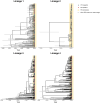HIV co-infection is associated with reduced Mycobacterium tuberculosis transmissibility in sub-Saharan Africa
- PMID: 38696531
- PMCID: PMC11093396
- DOI: 10.1371/journal.ppat.1011675
HIV co-infection is associated with reduced Mycobacterium tuberculosis transmissibility in sub-Saharan Africa
Abstract
Persons living with HIV are known to be at increased risk of developing tuberculosis (TB) disease upon infection with Mycobacterium tuberculosis (Mtb). However, it has remained unclear how HIV co-infection affects subsequent Mtb transmission from these patients. Here, we customized a Bayesian phylodynamic framework to estimate the effects of HIV co-infection on the Mtb transmission dynamics from sequence data. We applied our model to four Mtb genomic datasets collected in sub-Saharan African countries with a generalized HIV epidemic. Our results confirm that HIV co-infection is a strong risk factor for developing active TB. Additionally, we demonstrate that HIV co-infection is associated with a reduced effective reproductive number for TB. Stratifying the population by CD4+ T-cell count yielded similar results, suggesting that, in this context, CD4+ T-cell count is not a better predictor of Mtb transmissibility than HIV infection status alone. Together, our genome-based analyses complement observational household contact studies, and more firmly establish the negative association between HIV co-infection and Mtb transmissibility.
Copyright: © 2024 Windels et al. This is an open access article distributed under the terms of the Creative Commons Attribution License, which permits unrestricted use, distribution, and reproduction in any medium, provided the original author and source are credited.
Conflict of interest statement
The authors have declared that no competing interests exist.
Figures



Similar articles
-
[Impact of HIV and Mycobacterium tuberculosis co-infection on related mortality].Zhonghua Liu Xing Bing Xue Za Zhi. 2018 Oct 10;39(10):1362-1367. doi: 10.3760/cma.j.issn.0254-6450.2018.10.014. Zhonghua Liu Xing Bing Xue Za Zhi. 2018. PMID: 30453438 Chinese.
-
PD-1 Expression and Cytokine Secretion Profiles of Mycobacterium tuberculosis-Specific CD4+ T-Cell Subsets; Potential Correlates of Containment in HIV-TB Co-Infection.PLoS One. 2016 Jan 12;11(1):e0146905. doi: 10.1371/journal.pone.0146905. eCollection 2016. PLoS One. 2016. PMID: 26756579 Free PMC article.
-
Prognostic markers in HIV mono-and co-infected individuals: A study from Karachi-Pakistan.J Infect Public Health. 2018 Mar-Apr;11(2):250-254. doi: 10.1016/j.jiph.2017.07.027. Epub 2017 Aug 23. J Infect Public Health. 2018. PMID: 28844443
-
Interaction between HIV and Mycobacterium tuberculosis: HIV-1-induced CD4 T-cell depletion and the development of active tuberculosis.Curr Opin HIV AIDS. 2012 May;7(3):268-75. doi: 10.1097/COH.0b013e3283524e32. Curr Opin HIV AIDS. 2012. PMID: 22495739 Review.
-
HIV Prevalence Among Tuberculosis Patients in Sub-Saharan Africa: A Systematic Review and Meta-analysis.AIDS Behav. 2019 Jun;23(6):1561-1575. doi: 10.1007/s10461-018-02386-4. AIDS Behav. 2019. PMID: 30607755
Cited by
-
Household contact antigen-specific TNF and IL-2 T-cell responses and impact of index case Mycobacterium tuberculosis aerosolization and HIV Co-infection.Res Sq [Preprint]. 2024 Nov 20:rs.3.rs-4815117. doi: 10.21203/rs.3.rs-4815117/v1. Res Sq. 2024. Update in: Sci Rep. 2025 Jan 2;15(1):224. doi: 10.1038/s41598-024-83965-5. PMID: 39606489 Free PMC article. Updated. Preprint.
-
Infection with Mycobacterium tuberculosis alters the antibody response to HIV-1.PLoS Pathog. 2025 Aug 13;21(8):e1013350. doi: 10.1371/journal.ppat.1013350. eCollection 2025 Aug. PLoS Pathog. 2025. PMID: 40802847 Free PMC article.
-
Association of Mycobacterium tuberculosis aerosolization and HIV coinfection in the index case with T cell responses in household contacts.Sci Rep. 2025 Jan 2;15(1):224. doi: 10.1038/s41598-024-83965-5. Sci Rep. 2025. PMID: 39748008 Free PMC article.
References
-
- UNAIDS. Global AIDS update 2023. Geneva: UNAIDS; 2023.
MeSH terms
LinkOut - more resources
Full Text Sources
Medical
Research Materials

